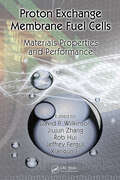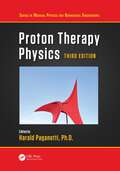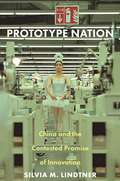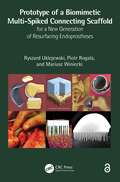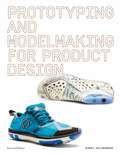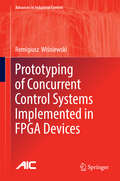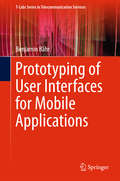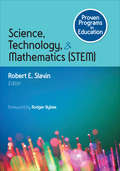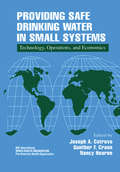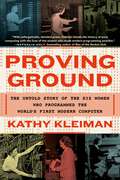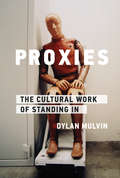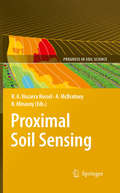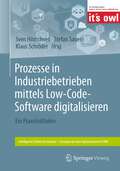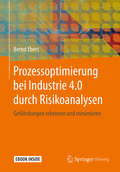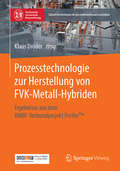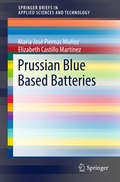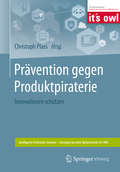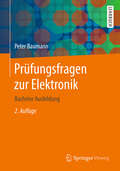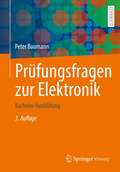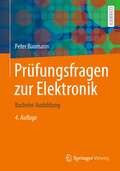- Table View
- List View
Proton Exchange Membrane Fuel Cells: Materials Properties and Performance (Green Chemistry and Chemical Engineering)
by Jiujun Zhang David P. Wilkinson Jeffrey Fergus Rob HuiA Detailed, Up-to-Date Treatment of Key Developments in PEMFC MaterialsThe potential to revolutionize the way we power our worldBecause of its lower temperature and special polymer electrolyte membrane, the proton exchange membrane fuel cell (PEMFC) is well-suited for transportation, portable, and micro fuel cell applications. But the performance o
Proton Therapy Physics (Series in Medical Physics and Biomedical Engineering)
by Harald PaganettiExpanding on the highly successful previous two editions, this third edition of Proton Therapy Physics has been updated throughout and includes several new chapters on “Adaptive Proton Therapy,” "Imaging for Planning,” “Flash Proton Therapy,” and “Outcome Modeling for Patient Selection.” Suitable for both newcomers in medical physics and more seasoned specialists in radiation oncology, this book provides an in‑depth overview of the physics of this radiation therapy modality, eliminating the need to dig through information scattered across medical physics literature.After tracing the history of proton therapy, this book explores the atomic and nuclear physics background necessary for understanding proton interactions with tissue. The text then covers dosimetry, including beam delivery, shielding aspects, computer simulations, detector systems, and measuring techniques for reference dosimetry. Important for daily operations, acceptance testing, commissioning, quality assurance, and monitor unit calibrations are outlined. This book moves on to discussions of imaging for planning and image guidance as well as treatment monitoring. Aspects of treatment planning for single‑ and multiple‑field uniform doses, dose calculation concepts and algorithms, and precision and uncertainties for nonmoving and moving targets are outlined. Finally, the biological implications of using protons from a physics perspective as well as outcome modeling are discussed.This book is an ideal practical guide for physicians, dosimetrists, radiation therapists, and physicists who already have some experience in radiation oncology. It is also an invaluable reference for graduate students in medical physics programs, physicians in their last year of medical school or residency, and those considering a career in medical physics.Key Features:• Updated with the latest technologies and methods in the field, covering all delivery methods of proton therapy, including beam scanning and passive scattering.• Discusses clinical aspects, such as treatment planning and quality assurance.• Offers insight into the past, present, and future of proton therapy from a physics perspective.Dr. Harald Paganetti is a distinguished figure in the field of radiation oncology, serving as Professor of Radiation Oncology at Harvard Medical School and Director of Physics Research at Massachusetts General Hospital. He earned his PhD in experimental nuclear physics from the Rheinische‑Friedrich‑Wilhelms University in Bonn, Germany, in 1992.
Prototype Nation: China and the Contested Promise of Innovation (Princeton Studies in Culture and Technology #29)
by Silvia M. LindtnerA vivid look at China’s shifting place in the global political economy of technology production How did China’s mass manufacturing and “copycat” production become transformed, in the global tech imagination, from something holding the nation back to one of its key assets? Prototype Nation offers a rich transnational analysis of how the promise of democratized innovation and entrepreneurial life has shaped China’s governance and global image. With historical precision and ethnographic detail, Silvia Lindtner reveals how a growing distrust in Western models of progress and development, including Silicon Valley and the tech industry after the financial crisis of 2007–8, shaped the rise of the global maker movement and the vision of China as a “new frontier” of innovation.Lindtner’s investigations draw on more than a decade of research in experimental work spaces—makerspaces, coworking spaces, innovation hubs, hackathons, and startup weekends—in China, the United States, Africa, Europe, Taiwan, and Singapore, as well as in key sites of technology investment and industrial production—tech incubators, corporate offices, and factories. She examines how the ideals of the maker movement, to intervene in social and economic structures, served the technopolitical project of prototyping a “new” optimistic, assertive, and global China. In doing so, Lindtner demonstrates that entrepreneurial living influences governance, education, policy, investment, and urban redesign in ways that normalize the persistence of sexism, racism, colonialism, and labor exploitation.Prototype Nation shows that by attending to the bodies and sites that nurture entrepreneurial life, technology can be extricated from the seemingly endless cycle of promise and violence.Cover image: Courtesy of Cao Fei, Vitamin Creative Space and Sprüth Magers
Prototype of a Biomimetic Multi-Spiked Connecting Scaffold for a New Generation of Resurfacing Endoprostheses
by Ryszard Uklejewski Piotr Rogala Mariusz WinieckiThe monograph comprehensively presents the research on the prototype of the biomimetic Multi-Spiked Connecting Scaffold (MSC-Scaffold) for cementless fixation of the components of a new generation of resurfacing arthroplasty (RA) endoprostheses. This research, carried out by a bioengineering-surgical team from three Polish universities, includes bioengineering design, rapid prototyping, manufacturing in selective laser melting, functionalization, surface modification, numerical studies, experimental in vitro studies, and pilot surgical experiments in an animal model. Features: Presents the prototype of the multi-spiked connecting scaffold for a new generation of resurfacing endoprostheses of the knee and the hip Explains this prototype scaffold as the first worldwide design of the biomimetic fixation of components of diarthrodial joints resurfacing endoprostheses Insights into the entire process of bioengineering design and research on this novel way of resurfacing endoprostheses fixation Reviews main results of the scaffold prototyping and SLM manufacturing, structural and osteoconductive functionalization, and surface modification Reports experimental and numerical investigations of mechanical behavior of the scaffold-bone system, cell culture studies, and pilot surgical experiments in animal models This book is aimed at professionals and graduate students in biomedical engineering, biomaterials engineering, and bone & joint surgery. The Open Access version of this book, available at http://www.taylorfrancis.com, has been made available under a Creative Commons [Attribution-Non Commercial-No Derivatives (CC-BY-NC-ND)] 4.0 license.
Prototyping and Modelmaking for Product Design: Second Edition
by Bjarki HallgrimssonNow in its second edition, Prototyping and Modelmaking for Product Design, by practising product development consultant Bjarki Hallgrimsson, is essential reading for both students and design professionals.Prototyping and ModelMaking for Product Design goes behind the scenes to illustrates how prototypes are used to help designers understand problems better, explore more imaginative solutions, investigate human interaction more fully and test functionality so as to de-risk the design process. Following an introduction on the purpose of prototyping, specific materials, tools and techniques are examined in detail, with step-by-step tutorials and industry examples of real and successful products illustrating how prototypes are used to help solve design problems. Workflow is also discussed, using a mixture of hands-on and digital tools.This new edition includes case studies representing technological developments such as prototyping user experience and interactive electronic products, as well as a new expanded section on digital modelmaking tools, including 3D printing and laser cutting.The first chapters of the book explain why prototyping is so important to the design process. The many uses of prototyping will be shown in the context of several comprehensive projects by some of the world's leading design firms.The second part is an introduction to the typical materials used by designers in their prototyping efforts and how to work with them. In all cases, the approach is to use digital and manual tools in a complementary and effective fashion. Tutorials were specifically developed that underline the back and forth of digital and manual ways of working. The emphasis is on the kinds of construction that can be done by the designers themselves. Health and safety is stressed in terms of personal responsibility and awareness.Topics covered include:Definition of prototyping and modelmakingPrototyping as a form of problem solvingModelmakingPhysical and digital prototypesBuidling by hand and using digital technologies
Prototyping and Modelmaking for Product Design: Second Edition
by Bjarki HallgrimssonNow in its second edition, Prototyping and Modelmaking for Product Design, by practising product development consultant Bjarki Hallgrimsson, is essential reading for both students and design professionals.Prototyping and ModelMaking for Product Design goes behind the scenes to illustrates how prototypes are used to help designers understand problems better, explore more imaginative solutions, investigate human interaction more fully and test functionality so as to de-risk the design process. Following an introduction on the purpose of prototyping, specific materials, tools and techniques are examined in detail, with step-by-step tutorials and industry examples of real and successful products illustrating how prototypes are used to help solve design problems. Workflow is also discussed, using a mixture of hands-on and digital tools.This new edition includes case studies representing technological developments such as prototyping user experience and interactive electronic products, as well as a new expanded section on digital modelmaking tools, including 3D printing and laser cutting.The first chapters of the book explain why prototyping is so important to the design process. The many uses of prototyping will be shown in the context of several comprehensive projects by some of the world's leading design firms.The second part is an introduction to the typical materials used by designers in their prototyping efforts and how to work with them. In all cases, the approach is to use digital and manual tools in a complementary and effective fashion. Tutorials were specifically developed that underline the back and forth of digital and manual ways of working. The emphasis is on the kinds of construction that can be done by the designers themselves. Health and safety is stressed in terms of personal responsibility and awareness.Topics covered include:Definition of prototyping and modelmakingPrototyping as a form of problem solvingModelmakingPhysical and digital prototypesBuidling by hand and using digital technologies
Prototyping of Concurrent Control Systems Implemented in FPGA Devices
by Remigiusz WiśniewskiThis book focuses on prototyping aspects of concurrent control systems and their further implementation and partial reconfiguration in programmable devices. Further, it lays out a full prototyping flow for concurrent control systems. Based on a given primary specification, a system is described with an interpreted Petri net, which naturally reflects the concurrent and sequential relationships of the design. The book shows that, apart from the traditional option of static configuration of the entire system, the latest programmable devices (especially FPGAs) offer far more sophistication. Partial reconfiguration allows selected parts of the system to be replaced without having to reprogram the entire structure of the device. Approaches to dynamic and static partial reconfiguration of concurrent control systems are presented and described in detail. The theoretical work is illustrated by examples drawn from various applications, with a milling machine and a traffic-light controller highlighted as representative interpreted Petri nets. Given the ubiquity of concurrent control systems in a huge variety of technological areas including transportation, medicine, artificial intelligence, manufacturing, security and safety and planetary exploration, the innovative software and hardware design methods described here will be of considerable interest to control engineers and systems and circuits researchers in many areas of industry and academia.
Prototyping of User Interfaces for Mobile Applications (T-Labs Series in Telecommunication Services)
by Benjamin BährThis book investigates processes for the prototyping of user interfaces for mobile apps, and describes the development of new concepts and tools that can improve the prototype driven app development in the early stages. It presents the development and evaluation of a new requirements catalogue for prototyping mobile app tools that identifies the most important criteria such tools should meet at different prototype-development stages. This catalogue is not just a good point of orientation for designing new prototyping approaches, but also provides a set of metrics for a comparing the performance of alternative prototyping tools. In addition, the book discusses the development of Blended Prototyping, a new approach for prototyping user interfaces for mobile applications in the early and middle development stages, and presents the results of an evaluation of its performance, showing that it provides a tool for teamwork-oriented, creative prototyping of mobile apps in the early design stages.
Proven Programs in Education: Science, Technology, and Mathematics (STEM)
by Robert E. SlavinLet the best evidence based practices guide you to STEM success. This series turns research into practice with practical, evidence-based advice from the world’s premier education researchers and authors. In this volume, top articles on science, technology, and math provide multiple perspectives on current STEM issues as well as strategies for effective teaching of STEM subjects at all grade levels. Each chapter offers: Research and case studies showcasing innovative approaches to teaching Best practices, validated by research, that have stood the test of time Practical advice you can put to work right away Sources for additional exploration of the research
Proven Programs in Education: Science, Technology, and Mathematics (STEM)
by Robert E. SlavinLet the best evidence based practices guide you to STEM success. This series turns research into practice with practical, evidence-based advice from the world’s premier education researchers and authors. In this volume, top articles on science, technology, and math provide multiple perspectives on current STEM issues as well as strategies for effective teaching of STEM subjects at all grade levels. Each chapter offers: Research and case studies showcasing innovative approaches to teaching Best practices, validated by research, that have stood the test of time Practical advice you can put to work right away Sources for additional exploration of the research
Proven Techniques for Keeping Healthy Chickens: The Backyard Guide to Raising Chicks, Handling Broody Hens, Building Coops, and More
by Carissa BonhamBeginning and intermediate chicken keepers don’t need to spend hours poring through extensive manuals and thick books—Carissa Bonham boils down chicken-keeping basics into 101 easy-to-understand and easy-to-apply tips, tricks, and chicken hacks. Advice ranges from learning how to grow your flock despite having a broody hen to directions for making a nesting box herb blend that will keep pests at bay and keep the coop smelling fresh. Other tips will touch on: • Waiting for info from author • Waiting for info from author • Waiting for info from author • And much more! Having raised a variety of chickens both inside her home and with the help of broody chicken moms, author Carissa Bonham is ready to share her chicken-keeping advice with others looking to add the joy of poultry to their lives. Her approach to chicken keeping focuses on keeping hens happy using natural methods so you can spend less time doing the dirty work and more time enjoying your flock.
Providing Safe Drinking Water in Small Systems: Technology, Operations, and Economics
by Joseph A. Cotruvo, Gunther F. Craun and Nancy HearneThe continued lack of access to adequate amounts of safe drinking water is one of the primary causes of infant morbidity and mortality worldwide and a serious situation which governments, international agencies and private organizations are striving to alleviate. Barriers to providing safe drinking water for rural areas and small communities that must be overcome include the financing and stability of small systems, their operation, and appropriate, cost-effective technologies to treat and deliver water to consumers.While we know how to technically produce safe drinking water, we are not always able to achieve sustainable safe water supplies for small systems in developed and developing countries. Everyone wants to move rapidly to reach the goal of universal safe drinking water, because safe water is the most fundamental essential element for personal and social health and welfare. Without safe water and a safe environment, sustained personal economic and cultural development is impossible. Often small rural systems are the last in the opportunity line.Safe Drinking Water in Small Systems describes feasible technologies, operating procedures, management, and financing opportunities to alleviate problems faced by small water systems in both developed and developing countries. In addition to widely used traditional technologies this reference presents emerging technologies and non-traditional approaches to water treatment, management, sources of energy, and the delivery of safe water.
Proving Ground: The Untold Story of the Six Women Who Programmed the World’s First Modern Computer
by Kathy KleimanDiscover a fascinating look into the lives of six historic trailblazers in this World War II-era story of the American women who programmed the world's first modern computer. After the end of World War II, the race for technological supremacy sped on. Top-secret research into ballistics and computing, begun during the war to aid those on the front lines, continued across the United States as engineers and programmers rushed to complete their confidential assignments. Among them were six pioneering women, tasked with figuring out how to program the world's first general-purpose, programmable, all-electronic computer—better known as the ENIAC—even though there were no instruction codes or programming languages in existence. While most students of computer history are aware of this innovative machine, the great contributions of the women who programmed it were never told—until now. Over the course of a decade, Kathy Kleiman met with four of the original six ENIAC Programmers and recorded extensive interviews with the women about their work. Proving Ground restores these women to their rightful place as technological revolutionaries. As the tech world continues to struggle with gender imbalance and its far-reaching consequences, the story of the ENIAC Programmers' groundbreaking work is more urgently necessary than ever before, and Proving Ground is the celebration they deserve.
Proxies: The Cultural Work of Standing In (Infrastructures)
by Dylan MulvinHow those with the power to design technology, in the very moment of design, are allowed to imagine who is included--and who is excluded--in the future.Our world is built on an array of standards we are compelled to share. In Proxies, Dylan Mulvin examines how we arrive at those standards, asking, "To whom and to what do we delegate the power to stand in for the world?" Mulvin shows how those with the power to design technology, in the very moment of design, are allowed to imagine who is included--and who is excluded--in the future.For designers of technology, some bits of the world end up standing in for other bits, standards with which they build and calibrate. These "proxies" carry specific values, even as they disappear from view. Mulvin explores the ways technologies, standards, and infrastructures inescapably reflect the cultural milieus of their bureaucratic homes. Drawing on archival research, he investigates some of the basic building-blocks of our shared infrastructures. He tells the history of technology through the labor and communal practices of, among others, the people who clean kilograms to make the metric system run, the women who pose as test images, and the actors who embody disease and disability for medical students. Each case maps the ways standards and infrastructure rely on prototypical ideas of whiteness, able-bodiedness, and purity to control and contain the messiness of reality. Standards and infrastructures, Mulvin argues, shape and distort the possibilities of representation, the meaning of difference, and the levers of change and social justice.
Proximal Soil Sensing
by Alex B. Mcbratney Budiman Minasny Raphael A. Viscarra RosselThis book reports on developments in Proximal Soil Sensing (PSS) and high resolution digital soil mapping. PSS has become a multidisciplinary area of study that aims to develop field-based techniques for collecting information on the soil from close by, or within, the soil. Amongst others, PSS involves the use of optical, geophysical, electrochemical, mathematical and statistical methods. This volume, suitable for undergraduate course material and postgraduate research, brings together ideas and examples from those developing and using proximal sensors and high resolution digital soil maps for applications such as precision agriculture, soil contamination, archaeology, peri-urban design and high land-value applications, where there is a particular need for high spatial resolution information. The book in particular covers soil sensor sampling, proximal soil sensor development and use, sensor calibrations, prediction methods for large data sets, applications of proximal soil sensing, and high-resolution digital soil mapping. Key themes: soil sensor sampling - soil sensor calibrations - spatial prediction methods - reflectance spectroscopy - electromagnetic induction and electrical resistivity - radar and gamma radiometrics - multi-sensor platforms - high resolution digital soil mapping - applications Raphael A. Viscarra Rossel is a scientist at the Commonwealth Scientific and Industrial Research Organisation (CSIRO) of Australia. Alex McBratney is Pro-Dean and Professor of Soil Science in the Faculty of Agriculture Food & Natural Resources at the University of Sydney in Australia. Budiman Minasny is a Senior Research Fellow in the Faculty of Agriculture Food & Natural Resources at the University of Sydney in Australia.
Proxy: An Avalon Novella
by Mindee ArnettProxy is an action-packed introduction to a world like nothing readers have seen before, and it sets a spark to the powder keg that will explode in Mindee Arnett's sci-fi thriller Avalon.If you need something stolen from any star system in the Confederation, you need look no further than the Shades. Jeth Seagrave and his band of teenage mercenaries have been making a name for themselves for being able to steal anything--and for disappearing before anyone is the wiser. Their latest job, a jewel heist on Grakkus, should be no different. But when Jeth's boss replaces a key member of his crew just before takeoff, and Jeth discovers a betrayal within his own ranks, he begins to suspect that not everyone is going to be coming back from his job alive.HarperTeen Impulse is a digital imprint focused on young adult short stories and novellas, with new releases the first Tuesday of each month.
Prozess- und Anlagensicherheit
by Ulrich HauptmannsStörfälle in technischen Anlagen sind Zufallsereignisse. Deshalb kann man sie nicht gänzlich vermeiden. Wohl aber lassen sich die Wahrscheinlichkeit ihres Auftretens und das Schadensausmaß verringern. In diesem Buch werden, ausgehend von Gefährdungen durch Stoffe und Betriebsbedingungen, mögliche technische und organisatorische Maßnahmen aufgezeigt, Gefährdungen zu mindern. Qualitative Analysemethoden zum Auffinden von Schwachstellen und zur Erhöhung der Sicherheit sowie Modelle zur Abschätzung von Störfallfolgen werden dargestellt. Die quantitative Bewertung der Wirksamkeit von Maßnahmen zur Verbesserung von Anlagentechnik und Sicherheit wird erläutert. Dabei spielen Unsicherheiten, die aus dem Zufallscharakter des Störfalls und aus Kenntnislücken bei einigen der zu behandelnden Phänomene folgen, eine Rolle. Der Leser wird mit Methoden der Störfallsimulation sowie Sicherheits- und Risikoanalysen vertraut gemacht und lernt, Möglichkeiten und Grenzen mathematischer Modellierung einzuschätzen. Als Grundlage sicherheitsrelevanter Entscheidungen wird die Risikoermittlung u.a. auf die Beurteilung der „funktionalen Sicherheit“ und die Bestimmung „angemessener Sicherheitsabstände“ zwischen Industrie und Bebauung angewandt. Zahlreiche ausgearbeitete Beispiele und Fallstudien realer Anlagen und Situationen vertiefen die Inhalte und erleichtern das Selbststudium.Die zweite Auflage des vorliegenden Buches eröffnete die Möglichkeit, den Text gründlich durchzusehen und eine Reihe von Korrekturen vorzunehmen. Zusätzliche Beispiele, die sich aus Anfragen aus der Praxis ergaben, wurden aufgenommen. Das Kapitel über „angemessene Sicherheitsabstände“ wurde um aktuelle Erfahrungen aus der Beratertätigkeit des Verfassers erweitert.
Prozesse in Industriebetrieben mittels Low-Code-Software digitalisieren: Ein Praxisleitfaden (Intelligente Technische Systeme – Lösungen aus dem Spitzencluster it’s OWL)
by Stefan Sauer Sven Hinrichsen Klaus SchröderIn vielen Unternehmen besteht ein steigender Bedarf an betriebsspezifisch gestalteten Softwareanwendungen, um Geschäftsprozesse zu digitalisieren und zu optimieren. Derzeit sind vor allem IT-Fachkräfte gefordert, diese Anwendungen zu entwickeln. Da in Betrieben vielfach ein Mangel an IT-Fachkräften besteht, ist diese Vorgehensweise zumeist mit langen Bereitstellungszeiten verbunden. Durch die Nutzung der Low-Code-Programmierung ist es hingegen möglich, Softwareanwendungen ohne tiefe Programmierkenntnisse mittels einer grafischen Benutzeroberfläche zu erstellen. Der Vorteil: Es können passgenaue Lösungen in kurzer Zeit entwickelt werden, indem sich Beschäftigte aus Fachabteilungen mit ihrem Expertenwissen direkt an der Softwareentwicklung beteiligen. Allerdings fehlt es in vielen Betrieben an Wissen zu den Anwendungsmöglichkeiten und -grenzen dieser Art der Programmierung. Zudem ist es derzeit für potenzielle Anwender oftmals unklar, wie eine anforderungsgerechte Low-Code-Plattform ausgewählt und eingeführt werden kann. In diesem Buch werden daher die Herausforderungen bei der Einführung von Low-Code-Plattformen erörtert und umfangreiche Gestaltungsempfehlungen vermittelt, damit es Betrieben gelingt, die wirtschaftlichen Potenziale der Low-Code-Programmierung zu nutzen.
Prozessoptimierung bei Industrie 4.0 durch Risikoanalysen: Gefährdungen Erkennen Und Minimieren
by Bernd EbertDas Buch beschreibt die Methodik der Risikoanalyse bei der Umsetzung von Industrie 4.0. Durch diese Methode können strukturelle und Schnittstellen-Probleme in vernetzten Systemen frühzeitig erkannt und geeignete Gegenmaßnahmen getroffen werden. Die theoretischen Ansätze zu Industrie 4.0 werden in 3 Betrachtungs-Ebenen gegliedert. Für jede dieser Ebenen werden die Spezifika beschrieben und mittels Risikoanalyse bewertet. Werden Risiken erkannt, folgen Vorschläge zu deren Minimierung. Neben den exakt definierbaren Stückgut-Prozessen (z.B. im Automotive-Bereich) ist eine Betrachtung z.B. von losen Mengen (wie eingesetzte Chemikalien) erforderlich. Da die Einführung von Industrie 4.0 nicht global schlagartig erfolgen wird, sind die zeitliche Abfolge der Einführung sowie Zwischenstufen bzgl. ihrer Risiken sowie deren Minimierung zu betrachten.Die ZielgruppenDas Buch wendet sich an Planungsingenieure für technische Systeme, MSR-Ingenieure, Softwareplaner, Begutachter für Prozess- und Anlagensicherheit und an Verantwortliche für technische Innovationen.
Prozesstechnologie zur Herstellung von FVK-Metall-Hybriden: Ergebnisse aus dem BMBF-Verbundprojekt ProVorPlus (Zukunftstechnologien für den multifunktionalen Leichtbau)
by Klaus DröderDieses Buch stellt den Abschlussbericht zum Verbundprojekt ProVorPlus vor. ProVorPlus leistet Beiträge zur anwendungsnahen Erforschung und Entwicklung großserientauglicher Fertigungs- und Produktionstechnologien für die wirtschaftliche Herstellung hybrider Leichtbaukomponenten und zum Aufbau von Prozessen zur Erzeugung flächiger Multi-Material-Fahrzeugstrukturen. Darüber hinaus werden Erkenntnisse über neuartige Produktionstechnologien vorgestellt, die zum einen die automatisierte Fertigung komplexer Vorformlinge in Multi-Material-Bauweise und zum anderen die Endkonsolidierung hybrider Bauteile durch die Verkettung von Einzelprozessen ermöglichen. Es wird dargestellt, wie die Technologien zum Abschluss in einer Prozesskette abgebildet und in Form von Anlagentechnik in der Open Hybrid LabFactory umgesetzt wurde.
Prussian Blue Based Batteries (SpringerBriefs in Applied Sciences and Technology)
by María José Piernas Muñoz Elizabeth Castillo MartínezThis book reviews the structure and composition of Prussian Blue materials. It presents the state-of-the-art of their application to metal-ion batteries, highlighting the benefits derived from the integration of electrochemical energy storage with clean energies. It concludes with future perspectives including prototyping and large-scale production.
Prävention gegen Produktpiraterie: Innovationen schützen (Intelligente Technische Systeme – Lösungen aus dem Spitzencluster it’s OWL)
by Christoph PlassIm Rahmen des Spitzenclusters it's OWL sind in den letzten 5 Jahren technisch innovative Lösungen entstanden, die den Unternehmen einen Wettbewerbsvorsprung ermöglichen. Dieses Know-how abzusichern und gegen Plagiatoren zu schützen, ist Gegenstand des Projekts Prävention gegen Produktpiraterie gewesen.Entstanden sind durchgängige Methodenketten zur Erarbeitung von ganzheitlichen Schutzkonzeptionen, die weit über die isolierten Ansätze konstruktiver Gestaltung des Produktes oder Markierungstechniken hinausgehen.Die Autoren zeigen die Systematik auf und belegen anhand von Praxisbeispielen, wie sie anzuwenden ist: Von der Analyse der Bedrohung, über die Festlegung von Schutzmaßnahmen bis hin zur Gestaltung von Bauteilen mit Hilfe moderner additiver Fertigungsverfahren, die Reverse Engineering erschweren.Das Buch zielt auf Praktiker in der Industrie, die sich mit dem Schutz ihrer Produkte befassen.
Prüfungsfragen zur Elektronik: Bachelor Ausbildung
by Peter BaumannDie in diesem Lehrbuch gestellten Prüfungsfragen beziehen sich auf die Funktion verschiedenartiger Halbleiter-Bauelemente als auch auf deren Zusammenwirken in Schaltungen. Die gegebenen Antworten erfolgen zunächst in Form kurz gefasster Erklärungen und werden anschließend mit Gleichungen und insbesondere mit Diagrammen aus PSPICE-Analysen anschaulich vertieft. Die Ausführung dieser Analysen wird nachvollziehbar dokumentiert. Die Prüfungsfragen zielen darauf ab, die jeweiligen Eigenschaften der Bauelemente bzw. Schaltungen schrittweise zu erfassen. Die mit den Prüfungsfragen angesprochenen Dioden, Thyristoren, bipolaren und unipolaren Transistoren, CMOS-Baugruppen sowie Operationsverstärker sind aus der frei zugänglichen Studenten-Version des Netzwerkanalyseprogramms PSPICE aufrufbar. Der nutzbare Schaltungsumfang reicht aus, um wichtige Grundschaltungen der Elektronik aufzubauen und zu analysieren. Die Antworten können daher mit konkreten Angaben versehen werden.
Prüfungsfragen zur Elektronik: Bachelor Ausbildung
by Peter BaumannDie in diesem Lehrbuch gestellten Prüfungsfragen beziehen sich auf die Wirkungsweise von elektronischen Bauelementen und Sensoren auf der Basis von PSPICE-Modellen und deren Anwendung in Schaltungen. Die Antworten werden durch die Angabe von Gleichungen und PSPICE-Analysen anschaulich unterstützt. Die Prüfungsfragen stehen insbesondere in enger Verbindung zum Laborpraktikum.
Prüfungsfragen zur Elektronik: Bachelor Ausbildung
by Peter BaumannDie in diesem Lehrbuch gestellten Prüfungsfragen beziehen sich auf die Wirkungsweise von elektronischen Bauelementen und Sensoren auf der Basis von PSPICE-Modellen und deren Anwendung in Schaltungen. Die Antworten werden durch die Angabe von Gleichungen und die Ausführung von PSPICE-Analysen anschaulich unterstützt. Die Prüfungsfragen stehen in enger Verbindung zum Laborpraktikum.
